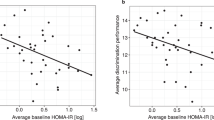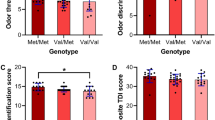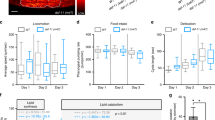Abstract
Polymorphisms in the gene encoding adiponectin receptor 1 (AdipoR1) are associated with insulin resistance, fatty liver, increased risk for type 2 diabetes and cardiovascular disease. AdipoR1 is expressed in the central nervous system and in the olfactory mucosa of mice and humans. We therefore hypothesized that a common polymorphism in AdipoR1 might alter olfactory function. We investigated a group of 222 healthy subjects (male: n=147, female: n=75) for olfactory recognition, and genotyped them for the polymorphism rs6666089 in the human AdipoR1 gene. This polymorphism has been previously shown to be associated with insulin resistance. Olfactory recognition was tested using standardized sniffing sticks, and parameters of glucose metabolism and serum adiponectin levels were assessed. We found a significant olfactory impairment in carriers of the AdipoR1 polymorphism rs6666089 (olfactory recognition: GG: 89.4±1.2%, GA: 86.9±1.4%, AA: 77.2±4.8%, additive model, P=0.0004, adjusted for age). Adiponectin levels had no impact on olfactory recognition. Fasting plasma glucose, fasting plasma insulin, body mass index and HbA1c did not differ between the genotype groups. In conclusion, the presence of a genetic variation in AdipoR1 is associated with decreased olfactory recognition in healthy subjects. Adiponectin signalling may have an important role in olfactory function and regulation of appetite.
This is a preview of subscription content, access via your institution
Access options
Subscribe to this journal
Receive 12 print issues and online access
$259.00 per year
only $21.58 per issue
Buy this article
- Purchase on Springer Link
- Instant access to full article PDF
Prices may be subject to local taxes which are calculated during checkout
Similar content being viewed by others
References
Scherer PE, Williams S, Fogliano M, Baldini G, Lodish HF . A novel serum protein similar to C1q, produced exclusively in adipocytes. J Biol Chem 1995; 270: 26746–26749.
Arita Y, Kihara S, Ouchi N, Takahashi M, Maeda K, Miyagawa J et al. Paradoxical decrease of an adipose-specific protein, adiponectin, in obesity. Biochem Biophys Res Commun 1999M; 257: 79–83.
Chandran M, Phillips SA, Ciaraldi T, Henry RR . Adiponectin: more than just another fat cell hormone? Diabetes Care 2003; 26: 2442–2450.
Goldstein BJ, Scalia R . Adiponectin: a novel adipokine linking adipocytes and vascular function. J Clin Endocrinol Metab 2004; 89: 2563–2568.
Yamauchi T, Kamon J, Ito Y, Tsuchida A, Yokomizo T, Kita S et al. Cloning of adiponectin receptors that mediate antidiabetic metabolic effects. Nature 2003; 423: 762–769.
Kadowaki T, Yamauchi T, Kubota N . The physiological and pathophysiological role of adiponectin and adiponectin receptors in the peripheral tissues and CNS. FEBS Lett 2008; 582: 74–80.
Tsuchida A, Yamauchi T, Ito Y, Hada Y, Maki T, Takekawa S et al. Insulin/Foxo1 pathway regulates expression levels of adiponectin receptors and adiponectin sensitivity. J Biol Chem 2004; 279: 30817–30822.
Crimmins NA, Martin LJ . Polymorphisms in adiponectin receptor genes ADIPOR1 and ADIPOR2 and insulin resistance. Obes Rev 2007; 8: 419–423.
Stefan N, Machicao F, Staiger H, Machann J, Schick F, Tschritter O et al. Polymorphisms in the gene encoding adiponectin receptor 1 are associated with insulin resistance and high liver fat. Diabetologia 2005; 48: 2282–2291.
Kubota N, Yano W, Kubota T, Yamauchi T, Itoh S, Kumagai H et al. Adiponectin stimulates AMP-activated protein kinase in the hypothalamus and increases food intake. Cell Metab 2007; 6: 55–68.
Qi Y, Takahashi N, Hileman SM, Patel HR, Berg AH, Pajvani UB et al. Adiponectin acts in the brain to decrease body weight. Nat Med 2004; 10: 524–529.
Kos K, Harte AL, da Silva NF, Tonchev A, Chaldakov G, James S et al. Adiponectin and resistin in human cerebrospinal fluid and expression of adiponectin receptors in the human hypothalamus. J Clin Endocrinol Metab 2007; 92: 1129–1136.
Hass N, Haub H, Stevens R, Breer H, Schwarzenbacher K . Expression of adiponectin receptor 1 in olfactory mucosa of mice. Cell Tissue Res 2008; 334: 187–197.
Seoane LM, Al-Massadi O, Caminos JE, Tovar SA, Dieguez C, Casanueva FF . Sensory stimuli directly acting at the central nervous system regulate gastric ghrelin secretion. An ex vivo organ culture study. Endocrinology 2007; 148: 3998–4006.
Le Floch JP, Le Lièvre G, Labroue M, Paul M, Peynegre R, Perlemuter L . Smell dysfunction and related factors in diabetic patients. Diabetes Care 1993; 16: 934–937.
Hummel T, Sekinger B, Wolf SR, Pauli E, Kobal G . ‘Sniffin’ sticks’: olfactory performance assessed by the combined testing of odor identification, odor discrimination and olfactory threshold. Chem Senses 1997; 22: 39–52.
Kobal G, Hummel T, Sekinger B, Barz S, Roscher S, Wolf S . ‘Sniffin’ sticks’: screening of olfactory performance. Rhinology 1996; 34: 222–226.
Wolfensberger M, Schnieper I . [‘Sniffin’ sticks’: a new system for olfactory assessment in routine clinical practice]. HNO 1999; 47: 629–636.
Eibenstein A, Fioretti AB, Simaskou MN, Sucapane P, Mearelli S, Mina C et al. Olfactory screening test in mild cognitive impairment. Neurol Sci 2005; 26: 156–160.
Hummel T, Konnerth CG, Rosenheim K, Kobal G . Screening of olfactory function with a four-minute odor identification test: reliability, normative data, and investigations in patients with olfactory loss. Ann Otol Rhinol Laryngol 2001; 110: 976–981.
Colbert HA, Bargmann CI . Environmental signals modulate olfactory acuity, discrimination, and memory in Caenorhabditis elegans. Learn Mem 1997; 4: 179–191.
Guillod-Maximin E, Roy AF, Vacher CM, Aubourg A, Bailleux V, Lorsignol A et al. Adiponectin receptors are expressed in hypothalamus and colocalized with proopiomelanocortin and neuropeptide Y in rodent arcuate neurons. J Endocrinol 2009; 200: 93–105.
Guthoff M, Tschritter O, Berg D, Liepelt I, Schulte C, Machicao F et al. Effect of genetic variation in Kv1.3 on olfactory function. Diabetes Metab Res Rev 2009; 25: 523–527.
Tschritter O, Machicao F, Stefan N, Schäfer S, Weigert C, Staiger H et al. A new variant in the human Kv1.3 gene is associated with low insulin sensitivity and impaired glucose tolerance. J Clin Endocrinol Metab 2006; 91: 654–658.
Acknowledgements
We thank all study participants for their cooperation. We gratefully acknowledge the excellent technical assistance of A Bury, A Guirguis, M Weisser and R Werner. We thank Mary-Ann Schneider for careful proof reading of the manuscript. The study was supported by a grant (Grant number 2 A I) from the Zentrum Ernährungsmedizin Tübingen-Hohenheim (ZEM).
Author information
Authors and Affiliations
Corresponding author
Ethics declarations
Competing interests
The authors declare no conflict of interest.
Rights and permissions
About this article
Cite this article
Guthoff, M., Tschritter, O., Berg, D. et al. A polymorphism in the gene encoding AdipoR1 affects olfactory recognition. Int J Obes 35, 873–876 (2011). https://doi.org/10.1038/ijo.2010.211
Received:
Revised:
Accepted:
Published:
Issue Date:
DOI: https://doi.org/10.1038/ijo.2010.211
Keywords
This article is cited by
-
ADIPOR1 is essential for vision and its RPE expression is lost in the Mfrprd6 mouse
Scientific Reports (2018)



